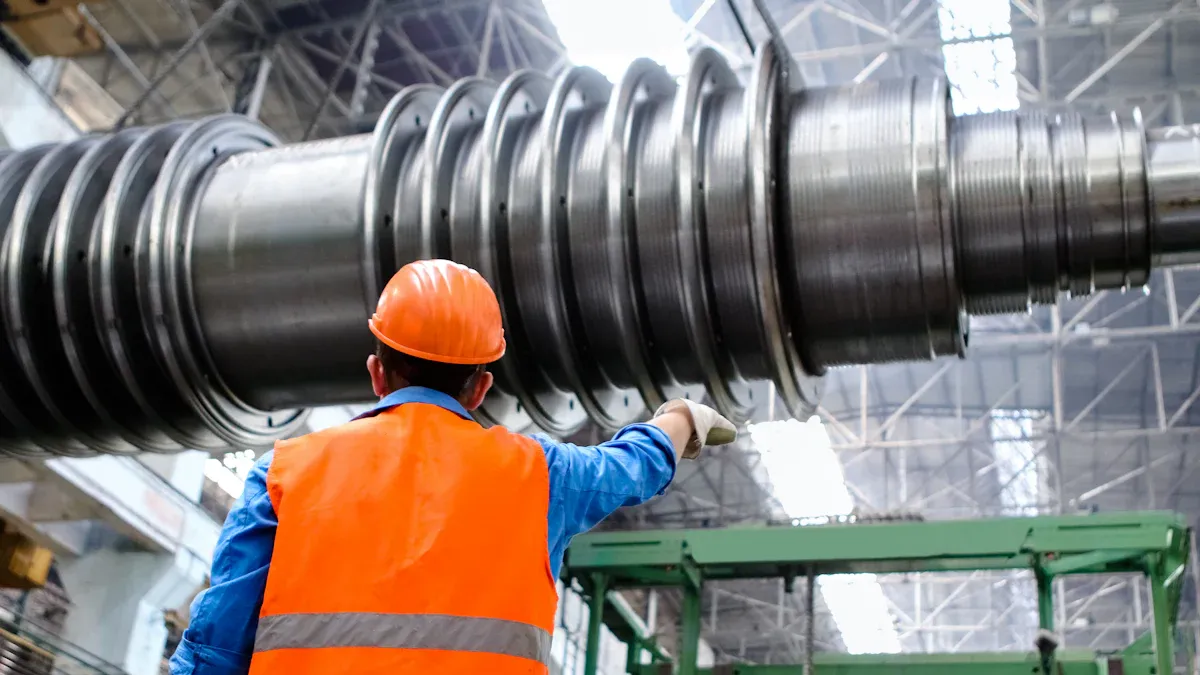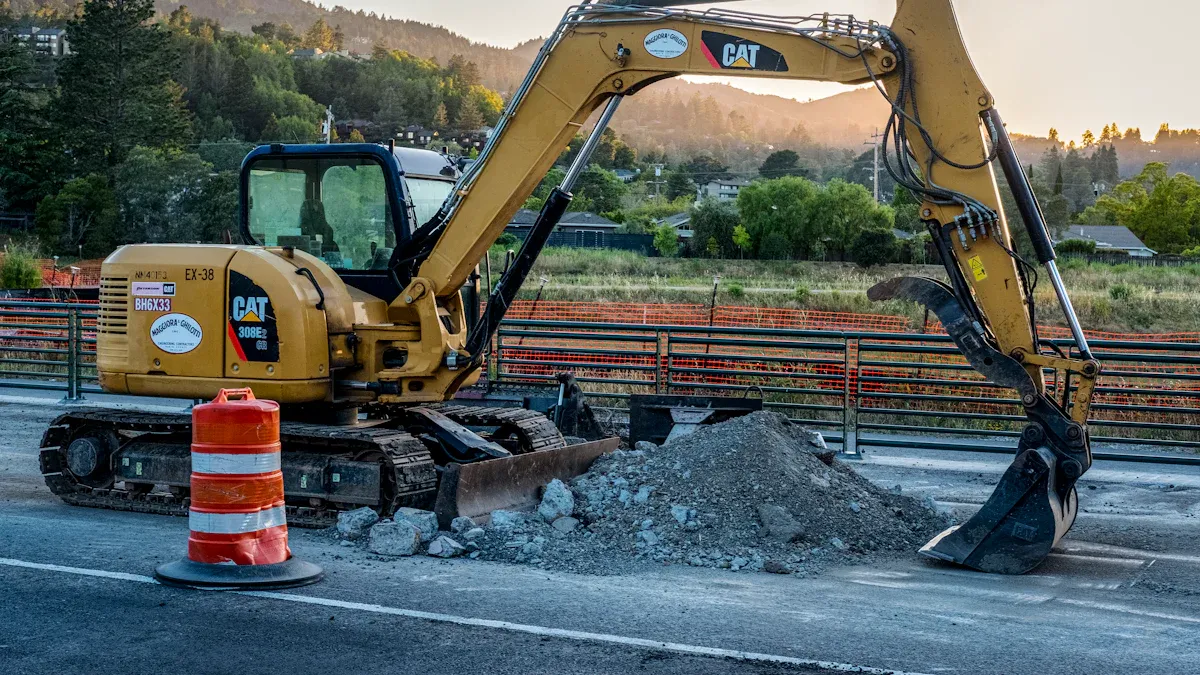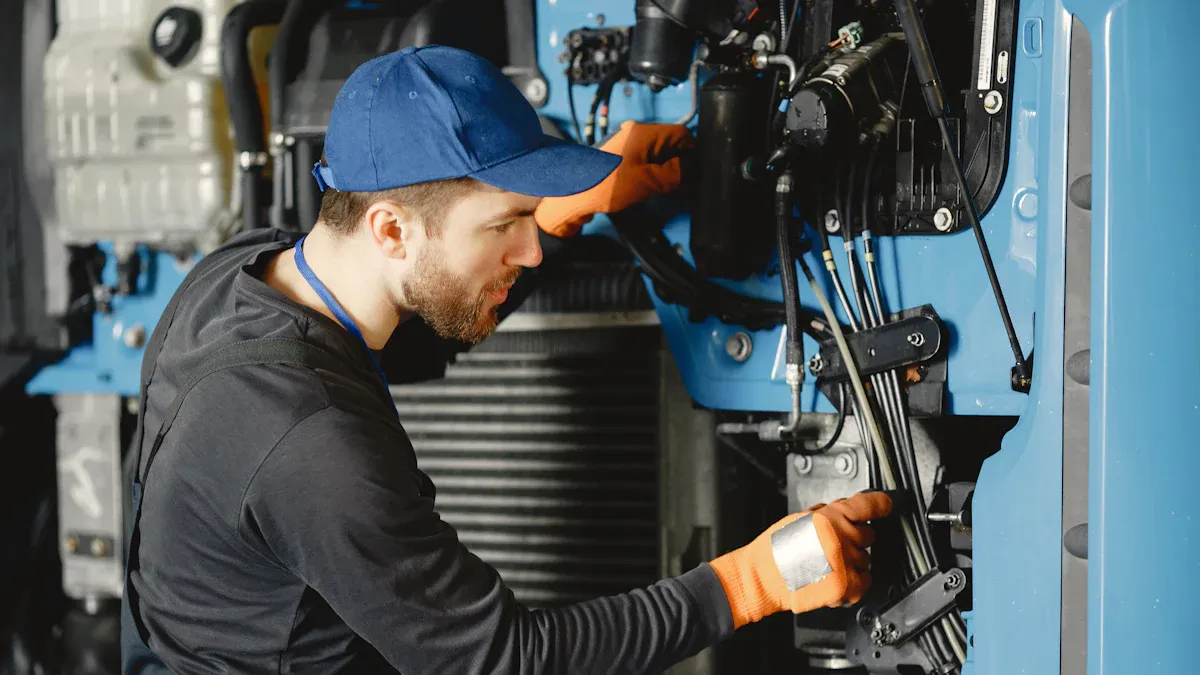
Maintaining sand making machine parts is crucial for ensuring consistent performance and saving costs. When you neglect these parts, the machine's efficiency drops, leading to reduced output and frequent breakdowns. Regular care minimizes downtime and prevents expensive repairs. Neglected wear parts can also affect the quality of your production, resulting in material waste. By prioritizing maintenance, you extend the lifespan of your sand making machine and ensure smooth operations. Small efforts today can save you significant time and money in the long run.

Regular inspections are essential for keeping your sand making machine in top condition. By routinely checking the machine, you can identify early signs of wear, loose parts, or damage. This proactive approach prevents minor issues from escalating into costly repairs. For example, inspecting the rotor for wear and tear allows you to replace worn-out tips promptly, ensuring consistent performance.
Adhering to a maintenance schedule, as outlined in the operation and maintenance manual, ensures the machine operates efficiently over time. Regular inspections also help maintain throughput by addressing potential blockages or inefficiencies before they impact production. A well-maintained machine not only lasts longer but also delivers better results.
Proactive maintenance involves taking steps to prevent problems before they occur. Start by keeping detailed records of all maintenance activities. This helps you track the condition of your sand making machine parts and plan for replacements or repairs.
Train your operators on proper operation and maintenance techniques. Skilled operators can identify unusual sounds or vibrations that may indicate a problem. Schedule regular professional servicing by qualified technicians to ensure all components are functioning correctly. Proactive maintenance reduces downtime, improves throughput, and extends the lifespan of your machine.
Proper lubrication and cleaning are vital for reducing friction and wear on moving parts. Use the recommended lubricants for your sand making machine and apply them at regular intervals. This minimizes friction, which can lead to overheating and damage.
Keep the machine clean by removing dust and debris regularly. Blockages caused by dirt can reduce efficiency and strain the machine's components. Pay special attention to feed tubes and liners, as these areas are prone to buildup. A clean and well-lubricated machine operates more smoothly, ensuring optimal performance and reducing the need for frequent repairs.
Recognizing early signs of wear and damage in your sand making machine parts is essential for preventing costly repairs and downtime. By staying alert to these indicators, you can address issues before they escalate. Here are some key signs to watch for:
Unusual Noises: Grinding, squealing, or rattling sounds often signal worn-out components. For example, a high-pitched squeal could indicate a loose or damaged 'V' belt.
Vibrations: Excessive vibrations may point to imbalanced rotors, misaligned bearings, or loose bolts. These vibrations not only reduce efficiency but also accelerate wear on other parts.
Visible Cracks or Deformations: Inspect parts like feed tubes, liners, and guard plates for cracks, dents, or warping. Even small cracks can grow over time, leading to part failure.
Reduced Performance: A drop in production output or inconsistent material quality often indicates wear on critical components like the impeller or rotor tips.
Overheating: Overheating can result from insufficient lubrication or excessive friction. Check for discoloration or a burning smell near bearings or other moving parts.
Tip: Keep a maintenance log to track recurring issues. This helps you identify patterns and address root causes effectively.
To detect these signs early, follow a systematic inspection routine:
Visual Checks: Examine all visible parts for wear, cracks, or buildup of debris. Use a flashlight to inspect hard-to-reach areas.
Listen Closely: Operate the machine at a low speed and listen for unusual sounds. This can help you pinpoint the source of the problem.
Feel for Vibrations: Place your hand on the machine's frame while it runs. Excessive vibrations often indicate internal issues.
Measure Performance: Monitor production rates and compare them to baseline levels. A noticeable drop may signal wear or damage.
Note: Always refer to the manufacturer's guidelines for specific inspection intervals and procedures.
By identifying these early warning signs, you can take timely action to replace or repair worn parts. This not only extends the life of your sand making machine but also ensures consistent performance and reduced downtime.

The 'V' belts in your sand making machine play a critical role in transferring power efficiently. Proper maintenance ensures they remain in good condition and perform optimally. Start by inspecting the belts regularly for signs of wear, such as cracks, fraying, or glazing. Replace any damaged belts immediately to prevent further issues.
Adjusting the tension of the belts is equally important. Loose belts can slip, reducing efficiency, while overly tight belts may cause unnecessary strain on the motor and other components. Refer to the manufacturer's guidelines for the correct tension levels.
When your machine uses double motors, ensure the 'V' belts are group matched and of equal length. This prevents uneven loading, which can lead to premature wear. The table below highlights key maintenance aspects for 'V' belts:
| Maintenance Aspect | Details |
|---|---|
| Tension Adjustment | Proper adjustment is crucial to ensure the belt is evenly loaded. |
| Double Motors Consideration | When using double motors, ensure the 'V' belts are group matched and of equal length. |
By following these practices, you can extend the lifespan of your 'V' belts and maintain consistent throughput.
Bearings are a core part of your sand making machine. They support rotational movement and reduce friction, ensuring smooth operation. Proper care and timely replacement of bearings are essential for wear parts maintenance.
Start by selecting high-quality bearings designed for harsh environments. Sand making machines often operate in dusty conditions with temperature fluctuations and moisture exposure. Bearings resistant to debris can significantly enhance their lifespan.
Handle bearings carefully during installation and maintenance. Improper handling can cause damage, leading to operational issues. Lubricate the bearings regularly using the recommended lubricant to minimize friction and prevent overheating.
Neglecting bearings can result in increased downtime and repair costs. Here are some key points to remember:
- Proper selection, handling, lubrication, and maintenance of bearings are crucial for reliable operation.
- Dust, temperature variations, and moisture increase the risk of bearing failure.
- Debris-resistant bearings minimize damage from contaminants, extending their lifespan.
By prioritizing bearing care, you can reduce the likelihood of unexpected failures and maintain the efficiency of your machine.
The rotor and impeller are critical wearing parts in your sand making machine. These components directly impact the machine's performance and the quality of the final product. Regular maintenance ensures they remain in top condition.
Inspect the rotor and impeller for signs of wear, such as uneven surfaces, cracks, or deformation. Worn-out rotor tips can reduce efficiency and affect material quality. Replace damaged tips promptly to maintain consistent performance.
Clean the rotor and impeller regularly to remove debris and buildup. Excessive material accumulation can cause imbalances, leading to vibrations and reduced throughput. Use a soft brush or compressed air to clean these parts without causing damage.
When replacing the rotor or impeller, always use parts recommended by the manufacturer. High-quality replacements ensure compatibility and durability, reducing the need for frequent repairs.
By maintaining the rot or and impeller, you can enhance the efficiency of your sand making machine and produce high-quality output consistently.
Feed tubes and liners are essential wearing parts in your sand making machine. They guide materials into the rotor and protect the machine from excessive wear. Proper care of these components ensures consistent throughput and reduces the need for frequent repair.
Start by inspecting the feed tubes regularly. Look for signs of wear, such as thinning walls or cracks. Damaged feed tubes can lead to uneven material flow, which affects the machine's efficiency. Replace worn-out tubes promptly to maintain optimal performance.
Liners, on the other hand, shield the internal surfaces of the machine from abrasion. Check the liners for grooves, dents, or other damage caused by material impact. If you notice significant wear, replace the liners with high quality replacements recommended by the manufacturer.
To extend the lifespan of these parts, follow these tips:
1. Use the Right Materials: Ensure the feed tubes and liners are made of durable, wear-resistant materials.
2. Clean Regularly: Remove debris and buildup to prevent blockages and uneven wear.
3. Monitor Material Flow: Uneven flow can accelerate wear on specific areas. Adjust the feed mechanism if necessary.
Tip: Keep spare feed tubes and liners on hand. This minimizes downtime when replacements are needed.
By maintaining feed tubes and liners, you can protect your sand making machine from unnecessary wear and ensure smooth operations.
Peripheral guard plates and other wear-resistant components play a crucial role in safeguarding your sand making machine. These parts absorb the impact of materials, reducing damage to the machine's core structure. Proper care of these components enhances the machine's durability and reduces repair costs.
Inspect the guard plates frequently. Look for cracks, chips, or signs of excessive wear. Damaged plates can compromise the machine's protection, leading to costly repairs. Replace worn-out plates immediately to avoid further damage.
When selecting replacement parts, prioritize high quality materials. Wear-resistant components made from durable alloys or composites last longer and provide better protection. Always choose parts that are compatible with your machine model.
Here are some maintenance tips for these components:
- Tighten Fasteners: Loose bolts or screws can cause the guard plates to shift, reducing their effectiveness.
- Check Alignment: Misaligned plates can expose the machine to unnecessary wear. Adjust them as needed.
- Clean Surfaces: Remove dust and debris to prevent buildup that can accelerate wear.
Note: Regular maintenance of wear-resistant components not only extends their lifespan but also improves the overall efficiency of your sand making machine.
By following these tips, you can ensure the longevity of your peripheral guard plates and other wear-resistant components. This reduces downtime and keeps your machine running at peak performance.
Following the manufacturer's guidelines is essential for safe and effective maintenance of your sand making machine. These guidelines provide specific instructions tailored to your machine's design and components. Ignoring them can lead to improper handling, which increases the risk of accidents and equipment damage.
For example, manufacturers often specify the correct tools to use, the recommended lubrication schedule, and the proper sequence for disassembling parts. Adhering to these instructions ensures that you perform maintenance tasks efficiently and safely. Additionally, many guidelines include safety protocols, such as wearing protective gear or avoiding certain materials that could damage the machine.
Tip: Keep the manufacturer's manual accessible at all times. It serves as a valuable reference for troubleshooting and routine maintenance tasks.
Using tools and equipment correctly during maintenance is critical for your safety and the machine's longevity. Mishandling tools can cause injuries or damage sensitive components. For instance, using the wrong wrench size may strip bolts, making future repairs more difficult.
Case studies highlight the importance of proper tool handling:
| Case Study Type | Key Findings |
|---|---|
| Vibration Analysis | Identifies bearing faults and unbalanced conditions through spectrum and timewave form analysis. |
| Oil Analysis | Detects dirty oil conditions and contaminants that lead to premature component failure. |
| Infrared Thermography | Catches temperature changes that in dicate potential failures, preventing costly shutdowns. |
These findings emphasize the need for precision and care when using diagnostic tools. Always inspect your tools before use to ensure they are in good condition. Damaged tools can compromise your safety and the quality of the maintenance work.
Disconnecting the power s upply is a non-negotiable step before starting any maintenance task. This precaution prevents accidental startups, which can result in severe injuries or even fatalities. OSHA mandates that machinery must be powered down and locked out during maintenance to protect workers from electrical hazards.
Lockout/Tagout (LOTO) procedures are highly effective in ensuring safety. These procedures involve shutting off the machine, isolating it from its energy source, and securing it with a lock to prevent accidental reactivation. A tragic incident once occurred due to a failure in grounding and securing power cables, underscoring the importance of this step.
Alert: Always double-check that the power is fully disconnected before beginning maintenance. This simple action can save lives and prevent costly accidents.
By following these safety precautions, you can create a safer working environment and ensure the proper upkeep of your sand making machine.
Using personal protective equipment (PPE) is essential when maintaining your sand making machine. PPE shields you from potential hazards, such as flying debris, sharp edges, and harmful dust. By wearing the right gear, you can reduce the risk of injuries and ensure a safer working environment.
Neglecting PPE can lead to severe consequences. According to OSHA, proper PPE use can prevent 712,000 lost workdays and 65,000 non-lost workday injuries annually. Additionally, an estimated 125 fatal head injuries occur each year, with four of these being preventable through proper PPE use. These stat istics highlight the importance of prioritizing safety during maintenance tasks.
Dr. Leonard Parver from Georgetown University’s ophthalmology department emphasized, “These injuries tend to be very devastating. They have severe impact on the patient in terms of vision, and the costs are phenomenal. We estimate the costs of hospitalizing these patients at $250 million per year.”
Equip yourself with the following PPE to stay protected:
- Safety Glasses or Goggles: Protect your eyes from flying particles and dust.
- Gloves: Prevent cuts and abrasions when handling sharp or rough components.
- Hard Hats: Shield your head from falling objects or accidental impacts.
- Dust Masks or Respirators: Reduce exposure to harmful dust and fine particles.
- Steel-Toed Boots: Safeguard your feet from heavy objects or sharp debris.
Inspect your PPE before each use. Look for cr acks, tears, or other damage.
Ensure a proper fit. Ill-fitting equipment may not provide adequate protection.
Replace worn-out PPE immediately. Compromised gear can fail when you need it most.
By using PPE consistently, you protect yourself from injuries and contribute to a safer workplace. Always prioritize safety to ensure smoot h and efficient machine maintenance.
Consistent care for your sand making machine parts ensures smooth operations and reduces unexpected breakdowns. Regular inspections, timely replacements, and scheduled maintenance tasks, like cleaning the main shaft bearing every 2000 working hours, help extend the machine's service life. These practices also i mprove performance by preventing dangerous situations and keeping all components in optimal condition.
By following these best practices, you save costs, reduce downtime, and enhance the efficiency of your operations. Start implementing these steps today to protect your investment and maintain a safer, more productive work environment.
Use a soft brush or compressed air to remove dust and debris. Avoid using water unless specified by the manufacturer. Regular cleaning prevents blockages and reduces wear on components.
Tip: Focus on areas like feed tubes, liners, and rotors where debris tends to accumulate.
Inspect wear parts weekly or after every 40 hours of operation. Regular checks help you identify early signs of damage, such as cracks or thinning.
Note: Follow the manufacturer's recommended inspection schedule for optimal results.
It’s best to use manufacturer-recommended parts. Generic parts may not fit properly or meet durability standards, leading to reduced performance and frequent repairs.
Alert: Using incompatible parts can void your machine’s warranty.
Check for imbalanced rotors, loose bolts, or misaligned bearings. Excessive vibrations often indicate internal issues that require immediate attention.
Tip: Tighten all fasteners and inspect the rotor for wear or damage.
Lubrication reduces friction between moving parts, preventing overheating and wear. It ensures smooth operation and extends the lifespan of components like bearings and rotors.
Reminder: Use only the lubricants recommended by the manufacturer for best results.